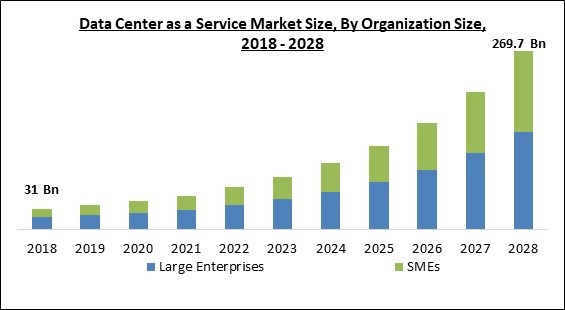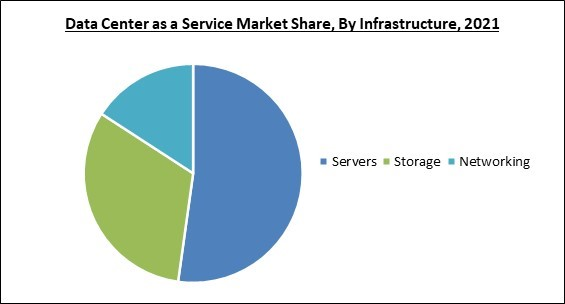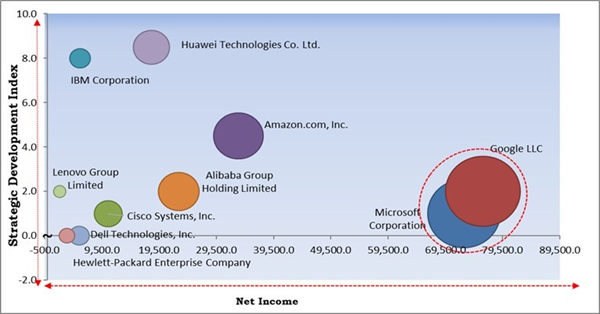The Global Data Center As A Service Market size is expected to reach $269.7 billion by 2028, rising at a market growth of 27.2% CAGR during the forecast period.
It is also anticipated that data center-as-a-service will gain more traction because it gives businesses a cost-effective way to increase the production of their IT operations without implementing physical resources. The need for controllers and big spaces was reduced by the data center as a service. By using outside cloud service providers, this idea enables businesses to reduce the number of employees working in their private data centers.
Furthermore, it enables vendors to construct data center that requires little to no human interaction and is easily serviced by robots. Automation is made possible and data centers' footprints can be packed closer together, lowering operational costs. Businesses are expected to adopt the Data Center as a Service model to reduce spending and cut operational as well as overhead costs due to the pandemic outbreak's increased workload on the cloud and the revenue loss for several businesses.
Organizations are adopting cloud storage and computing solutions as a result of the significant growth in data volumes caused by the expanding IoT and 5G penetration. As a result, the pandemic outbreak had a positive effect on the DCaaS market, leading to the adoption of the DCaaS model by a number of large corporations and SMEs in order to handle increased workloads. There is expanding due to the rising use of portable data storage devices for data retrieval regardless of time or location.
The major strategies followed by the market participants are Geographical Expansions. Based on the Analysis presented in the Cardinal matrix; Microsoft Corporation, and Google LLC are the forerunners in the Data Center As A Service Market. Companies such as Amazon.com, Inc. Alibaba Group Holding Limited and Huawei Technologies Co. Ltd. are some of the key innovators in Data Center As A Service Market.
The market research report covers the analysis of key stake holders of the market. Key companies profiled in the report include Amazon.com, Inc., IBM Corporation, Microsoft Corporation, Google LLC, Dell Technologies, Inc., Alibaba Group Holding Limited, Huawei Technologies Co. Ltd., Hewlett-Packard Enterprise Company, Cisco Systems, Inc., and Lenovo Group Limited.
It is also anticipated that data center-as-a-service will gain more traction because it gives businesses a cost-effective way to increase the production of their IT operations without implementing physical resources. The need for controllers and big spaces was reduced by the data center as a service. By using outside cloud service providers, this idea enables businesses to reduce the number of employees working in their private data centers.
Furthermore, it enables vendors to construct data center that requires little to no human interaction and is easily serviced by robots. Automation is made possible and data centers' footprints can be packed closer together, lowering operational costs. Businesses are expected to adopt the Data Center as a Service model to reduce spending and cut operational as well as overhead costs due to the pandemic outbreak's increased workload on the cloud and the revenue loss for several businesses.
Organizations are adopting cloud storage and computing solutions as a result of the significant growth in data volumes caused by the expanding IoT and 5G penetration. As a result, the pandemic outbreak had a positive effect on the DCaaS market, leading to the adoption of the DCaaS model by a number of large corporations and SMEs in order to handle increased workloads. There is expanding due to the rising use of portable data storage devices for data retrieval regardless of time or location.
COVID-19 Impact Analysis
Because data centers as a service have a much higher volume data handling capacity than on-premises data centers, many businesses are likely to choose them. Besides that, the pandemic raised the data volumes by encouraging more people to use social media and other digital technologies. The adoption of data centers as a service is anticipated to be fueled by the growing shift towards cloud computing. Thus, the COVID-19 outbreak had a favorable effect on the market, leading to positive growth throughout the pandemic, which is anticipated to continue over the forecast period.Market Growth Factors
Quick Adoption Of The Model For Subscription-Based Services
One of the key factors propelling the device-as-a-service market is the quick uptake of the subscription-based services model. Consumers can convert the high cost of buying new technology from a capital spending (CapEx) to an operating expense by using subscription-based device-as-a-service models (OpEx). Small, medium-sized, and large businesses can do this to free up cash for investments in lucrative strategic initiatives.Introduction Of WaaS (Wearables As A Service) Model Among Enterprises
Wearable technologies, like virtual reality (VR) headsets, smartwatches, augmented reality (AR) glasses, and medical patches, are practical and gaining popularity among end users, including business enterprises. These organizations primarily seek to gain from the mobility as well as interoperability that come with wearable technologies, as well as the enormous amount of data generated. To promote wearables-as-a-service (WaaS) solutions, numerous businesses have recently started producing wearable technology.Market Restraining Factors
Lack Of Knowledge About The Advantages Of This Model
A significant barrier to the device-as-a-service model's adoption and, consequently, to its expansion, is a lack of knowledge about the advantages it provides. Companies in developing nations like India, Brazil, China, and Indonesia have a relatively low adoption of these services because they are not aware of the advantages provided by device-as-a-service, such as data security, cost-effectiveness, and a wide range of devices available for selection; as a result, they are less willing to adopt this service model.Infrastructure Outlook
On the basis of infrastructure, the data as a service market is segmented into servers, storage and networking. In 2021, the storage segment acquired a significant revenue share in the data center as a service market. The expansion of both structured and unstructured information is responsible for this sector's expansion. Moreover, it is anticipated that increased usage of streaming services and digital platforms during the pandemic will aid in the expansion of the storage market.Organization Size Outlook
Based on organization size, the data as a service market is classified into SMEs, and large enterprises. In 2021, the large enterprise segment held the largest revenue share in the data center as a service market. A number of large businesses are upgrading their IT infrastructure in order to run cutting-edge processes and applications based on IoT and big data analytics. Large businesses also process a lot of data, which necessitates a lot of storage space.Vertical Outlook
By vertical, the data as a service market is fragmented into retail, BFSI, IT & Telecom, healthcare, manufacturing and others. In 2021, the IT & telecom segment witnessed the highest revenue share in the data center as a service market. In the upcoming years, a significant amount of data is anticipated to be produced due to the rollout of 5G and the increase in internet traffic worldwide.Regional Outlook
Region wise, the data as a service market is analyzed across the North America, Europe, Asia Pacific and LAMEA. In 2021, the North America region led the data center as a service market with the largest revenue share. The demand for data processing across numerous industries and technological advancements is expected to drive market expansion. A large number of vendors for the data center as a service are present in the region. Furthermore, there is a strong telecom networks and government initiatives which will accelerate the adoption of DCaaS in this region.Cardinal Matrix-Data Center as a Service Market Competition Analysis
The major strategies followed by the market participants are Geographical Expansions. Based on the Analysis presented in the Cardinal matrix; Microsoft Corporation, and Google LLC are the forerunners in the Data Center As A Service Market. Companies such as Amazon.com, Inc. Alibaba Group Holding Limited and Huawei Technologies Co. Ltd. are some of the key innovators in Data Center As A Service Market.
The market research report covers the analysis of key stake holders of the market. Key companies profiled in the report include Amazon.com, Inc., IBM Corporation, Microsoft Corporation, Google LLC, Dell Technologies, Inc., Alibaba Group Holding Limited, Huawei Technologies Co. Ltd., Hewlett-Packard Enterprise Company, Cisco Systems, Inc., and Lenovo Group Limited.
Strategies deployed in Data Center as a Service Market
Partnerships, Collaborations and Agreements:
- May-2022: Huawei partnered with Centrin Data, an IT infrastructure provider of integrated IT services. Under this partnership, the companies would partner in data center infrastructure, data center business, green energy storage, smart photovoltaics, comprehensive smart energy management, and 'other fields.
- May-2022: Lenovo came into a partnership with Kyndryl, an American multinational information technology infrastructure service. This partnership aimed at providing integrated solutions for consumers via an edge-to-cloud experience that leverages Lenovo’s diverse portfolio of products spanning edge computing, PCs, mobile, and data centers with Kyndryl’s customizable services for deployment, migration, and optimization as a service or on-premise.
- Oct-2021: Huawei collaborated with Cloud Exchange, an integrated managed services provider for multiple clouds. Under this collaboration, the companies launched Africa’s first uptime institute tier IV modular prefabricated data center. This collaboration focused on the Cloud Exchange’s expansion of its service offerings from systems integration, and hybrid cloud infrastructure to Tier IV data center colocation, interconnects and cross-connects, managed network & security, and private & public cloud services.
Product Launches and Product Expansions:
- Jun-2022: Huawei launched PowerPOD 3.0, a new generation of power supply solutions. PowerPOD 3.0 optimizes the layout and builds a worry-free data center power supply system that saves power, footprint, and time through its core technology innovations & component convergence.
Acquisition & Mergers:
- Jul-2022: IBM completed the acquisition of Databand, a leading provider of data observability software. This acquisition would further strengthen IBM's software portfolio across data, AI, and automation to address the full spectrum of observability and helps businesses ensure that trustworthy data is being put into the right hands of the right users at the right time. Furthermore, the acquisition would enable IBM to address the full spectrum of observability across IT operations.
- Jul-2021: IBM signed an agreement to acquire Bluetab Solutions Group, an enterprise software, and technical services company. Under this acquisition, Bluetab would become a strategic part of IBM's data services consulting practice to further advance its hybrid cloud and AI strategy. The acquisition of Bluetab would fuel migration to the cloud and help the clients to realize even more value from their mission-critical data.
Geographical Expansions:
- Aug-2022: Amazon expanded its geographical footprints in UAE by launching AWS in the region. This expansion enables more consumers to harness the power of the cloud to drive innovation in the UAE, while also investing in the local economy through job creation, training for highly sought-after technology skills, and education resources to further enhance the UAE’s strategic priorities.
- Aug-2022: Microsoft expanded its geographical footprint in Qatar by opening a new data center in the region. This expansion would provide access to highly available, scalable, and resilient cloud services to accelerate the digital transformation and advance intelligent cloud adoption of businesses, consumers, and partners across Qatar.
- Jun-2022: Huawei expanded its geographical footprints in Chile. The expansion would more facilities to ease the task of recovering data in the event of a natural disaster.
- Jun-2022: Alibaba expanded its geographical footprint in Saudi Arabia by opening a new data center. The expansion would help provide a wide range of public cloud services to help step up digitalization initiatives by small & medium-sized enterprises and major companies across a range of industries.
- May-2022: Cisco expanded its geographical footprint in India. This expansion focused on fulfilling consumer demand for cyber-defense & data localization. Further, the expansion is a step forward in the company's global expansion strategy. The local data center would allow various organizations to improve their performance by enhancing connection stability.
- Mar-2022: Microsoft expanded its geographical footprint in India by opening a new data center in Hyderabad, India. The expansion focused on delivering advanced data security and cloud solutions that would help enterprises, start-ups, education, developers, and government institutions.
- Mar-2022: Alibaba expanded its geographical footprints in Frankfurt, Germany. This expansion would provide a range of cloud computing products ranging from storage and network to databases. The newly established data center adheres to the highest security standards as well as strict compliance regulations set out in the Cloud Computing Compliance Controls Catalog (C5) in Germany.
- Oct-2021: Alibaba Cloud expanded its geographical footprints in South Korea. The expansion aimed at offering South Korean consumers more reliable, secure, and scalable cloud services, underlining its commitment to empower South Korean businesses with their digital transformation. This expansion would enable local businesses of all sizes would be able to deploy mission-critical workloads while enjoying more reliable cloud services with lower latency.
- Jun-2021: Alibaba Cloud expanded its geographical footprints in the Philippines. This expansion aimed at extending the reach of its services including elastic compute, databases, security, machine learning, and data analytics.
- May-2021: Cisco expanded its geographical footprint in Frankfurt, Germany. Through this expansion, Cisco focused on serving consumers using its Collaboration platform Webex in the European Union and Europe, Middle East, Africa, and Russia region.
Scope of the Study
Market Segments Covered in the Report:
By Organization Size
- Large Enterprises
- SMEs
By Infrastructure
- Servers
- Storage
- Networking
By Vertical
- IT & Telecom
- BFSI
- Retail
- Healthcare
- Manufacturing
- Others
By Geography
- North America
- US
- Canada
- Mexico
- Rest of North America
- Europe
- Germany
- UK
- France
- Russia
- Spain
- Italy
- Rest of Europe
- Asia Pacific
- China
- Japan
- India
- South Korea
- Singapore
- Australia
- Rest of Asia Pacific
- LAMEA
- Brazil
- Argentina
- UAE
- Saudi Arabia
- South Africa
- Nigeria
- Rest of LAMEA
Key Market Players
List of Companies Profiled in the Report:
- Amazon.com, Inc.
- IBM Corporation
- Microsoft Corporation
- Google LLC
- Dell Technologies, Inc.
- Alibaba Group Holding Limited
- Huawei Technologies Co. Ltd.
- Hewlett-Packard Enterprise Company
- Cisco Systems, Inc.
- Lenovo Group Limited
Unique Offerings from the Publisher
- Exhaustive coverage
- The highest number of Market tables and figures
- Subscription-based model available
- Guaranteed best price
- Assured post sales research support with 10% customization free
Table of Contents
Chapter 1. Market Scope & Methodology
Chapter 2. Market Overview
Chapter 3. Competition Analysis - Global
Chapter 4. Global Data Center as a Service Market by Organization Size
Chapter 5. Global Data Center as a Service Market by Infrastructure
Chapter 6. Global Data Center as a Service Market by Vertical
Chapter 7. Global Data Center as a Service Market by Region
Chapter 8. Company Profiles
Companies Mentioned
- Amazon.com, Inc.
- IBM Corporation
- Microsoft Corporation
- Google LLC
- Dell Technologies, Inc.
- Alibaba Group Holding Limited
- Huawei Technologies Co. Ltd.
- Hewlett-Packard Enterprise Company
- Cisco Systems, Inc.
- Lenovo Group Limited
Methodology

LOADING...











